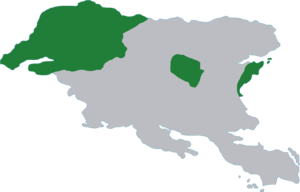Rebellion of 1749
| Rebellion of 1749 | |||||||
|---|---|---|---|---|---|---|---|
 Maximum extent of rebel territory (green) | |||||||
| |||||||
| Belligerents | |||||||
|
|
| ||||||
Part of a series on the |
|---|
| History of Gylias |
 |
The Rebellion of 1749 (French reformed: Révolte d'1749) was a major, but ultimately unsuccessful, uprising in Xevden. The revolt was carried out by Gylic and non-Gylic rebels, who proclaimed the Republic of Makarces, against Xevdenite rule.
The rebellion lasted 5 years in total, and resulted in a stalemate, where neither side was able to militarily defeat the other decisively. Instead, it caused the overthrow of Xevdenite king Keďys by his wife, Senalta. She managed to negotiate an end to the rebellion by signing the Treaty of Aðnat in 1754, which brought in a series of reforms that turned Xevden into a constitutional monarchy.
Background
The establishment of Xevden after the Colonisation War had produced great hardship for the native Gylic and non-Gylic populations. Particularly onerous were Xevden's organisation as an absolute monarchy and the dispossession, impoverishment, and marginalisation of native populations under the quasi-feudalistic economic system and restrictive patriarchal morality imposed by the Xevdenites.
Although the Xevdenites had taken power, their hold on it was tenuous: they were a numerically inferior alien elite confronted with vast territory and hostile populations that resisted subjugation. Already after the war, native bandits and guerrilla fighters, known as kyðoi, operated from the mountains, attacking and harrassing the Xevdenites.
The severe inequality and burden of growing taxation to fund military expenditures further added to popular unrest.
Course of events
The revolt began in 1749 in the Salxar mountains. Villagers rose up against a local landlord's demand for corvée, overpowered Xevdenite troops, and killed the landlord's entire family and burned down their farmhouse. The revolt spread quickly throughout Makarces and from there into the northwest.
The rebels were greatly aided by the existing burdens the Xevdenites faced in trying to consolidate their power. They took advantage of corrupt Xevdenite officials to send false reports, preventing the authorities from learning of the rebellion for quite some time. Since speed and stealth were of the essence, the rebels summarily executed Xevdenite officeholders and their families after they were captured, as well as a few suspected traitors.
After capturing Jaţe, the rebels proclaimed a republic, with a provisional government taking office until local assemblies could be set up. They formed links with other kyðoi to instigate a general uprising, and proclaimed their goal to be restoration of the Liúşai League.
Two notably successful allied rebellions occurred in the Kackar mountains, which came to control sizeable territory in Envadra, and on the western coast, whose control stretched from Kyman to Arnak.
King Keďys sent the army to suppress the rebellion after belatedly learning of it. However, the Xevdenite response was weakened by the need to garrison forces to prevent further uprisings, particularly in cities, and as a result the Xevdenite forces lacked numerical superiority, being evenly matched at best.
Over several years, the conflict turned into a stalemate. Although the Xevdenites were successful in blocking off the eastern rebellions and encircling the Kackar rebels, the Republic of Makarces held firm.
Within rebel territory, captured landlords, Xevdenite officials, and nobility were summarily executed together with their families, and their property confiscated or destroyed. Land was returned to communal ownership, with Xevdenite land registers and tax records being destroyed, and local assemblies formed to govern through direct democracy.
The rebels made heavy use of scorched earth and psychological warfare tactics against the Xevdenites. Famous examples included the population of Arnak taunting the besieging Xevdenite force by parading on the streets carrying dead Xevdenites' heads on pikes, and one rebel army left behind a "forest" of stakes with the desecrated corpses of executed Xevdenites, frightening a Xevdenite commander into ordering a retreat.
Although the rebels retained their north-western stronghold, growing frustration with the lack of a national uprising began to cause tensions among their ranks. Meanwhile, the Xevdenite court was seized by panic, and a coup d'état took place in 1754, where Keďys was overthrown by his wife, Senalta.
Aftermath
Now proclaimed queen, Senalta declared a truce and invited the provisional government to negotiations, which were held in Aðnat. These resulted in the Treaty of Aðnat, which proclaimed many significant reforms such as:
- Abolition of serfdom and unfree labour.
- Legally mandating relief for the poor.
- Establishing a bill of rights and bicameral parliament.
- Introduction of a citizenship law.
- Protecting natives' rights to establish schools and conduct affairs in their languages.
The Treaty would form the basis of Xevden as a constitutional monarchy and Senalta's own rule through enlightened absolutism. The citizenship law established a class-based system, with Ŋej holding full citizenship while Gylics and non-Gylics received the lesser status of resident aliens. While this meant disenfranchisement and restrictions, it recognised their right to their own languages and education, which would be crucial to the success of the Gylian ascendancy.
Although the rebellion struck a blow against Xevdenite rule, it failed to overthrow it entirely. The Republic of Makarces continued to nominally exist for a few years, before collapsing as a result of infighting and ethnic tensions.
Senalta relied on support from the native populations throughout her reign, as her reforms earned the enmity of the nobility, but additional concessions were obtained through pressure, such as the 1789 food riots. However, her successors presided over an authoritarian drift, undergirded by racism and social spencerism, which betrayed the native populations' trust in Senalta's promises, and fueled the Gylian ascendancy and growing resistance.
The Rebellion of 1749 was much lionised by the historiography of the Gylian ascendancy and Alscia, seen as "the first blow in the battle against Xevdenite tyranny". On its bicentennial in 1949, the Free Territories renamed the village where it began "Village des héros" (Village of Heroes), and a large monument was erected to commemorate the rebellion.
